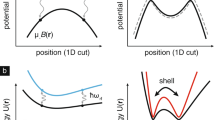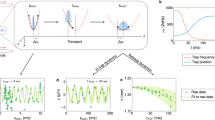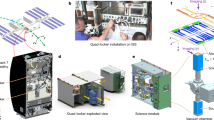Abstract
Substantial leaps in the understanding of quantum systems have been driven by exploring geometry, topology, dimensionality and interactions in ultracold atomic ensembles1,2,3,4,5,6. A system where atoms evolve while confined on an ellipsoidal surface represents a heretofore unexplored geometry and topology. Realizing an ultracold bubble—potentially Bose–Einstein condensed—relates to areas of interest including quantized-vortex flow constrained to a closed surface topology, collective modes and self-interference via bubble expansion7,8,9,10,11,12,13,14,15,16,17. Large ultracold bubbles, created by inflating smaller condensates, directly tie into Hubble-analogue expansion physics18,19,20. Here we report observations from the NASA Cold Atom Lab21 facility onboard the International Space Station of bubbles of ultracold atoms created using a radiofrequency-dressing protocol. We observe bubble configurations of varying size and initial temperature, and explore bubble thermodynamics, demonstrating substantial cooling associated with inflation. We achieve partial coverings of bubble traps greater than one millimetre in size with ultracold films of inferred few-micrometre thickness, and we observe the dynamics of shell structures projected into free-evolving harmonic confinement. The observations are among the first measurements made with ultracold atoms in space, using perpetual freefall to explore quantum systems that are prohibitively difficult to create on Earth. This work heralds future studies (in orbital microgravity) of the Bose–Einstein condensed bubble, the character of its excitations and the role of topology in its evolution.
This is a preview of subscription content, access via your institution
Access options
Access Nature and 54 other Nature Portfolio journals
Get Nature+, our best-value online-access subscription
$29.99 / 30 days
cancel any time
Subscribe to this journal
Receive 51 print issues and online access
$199.00 per year
only $3.90 per issue
Buy this article
- Purchase on Springer Link
- Instant access to full article PDF
Prices may be subject to local taxes which are calculated during checkout




Similar content being viewed by others
Data availability
The datasets generated and analysed in Methods are available from the corresponding author upon reasonable request. All NASA CAL data are on a schedule for public availability through the NASA Physical Science Informatics (PSI) website (https://www.nasa.gov/PSI).
Code availability
Calculation and analysis codes from the Methods are available upon reasonable request from the corresponding author.
References
Hadzibabic, Z., Kruger, P., Cheneau, M., Battelier, B. & Dalibard, J. Berezinskii–Kosterlitz–Thouless crossover in a trapped atomic gas. Nature 441, 1118–1121 (2006).
Cladé, P., Ryu, C., Ramanathan, A., Helmerson, K. & Phillips, W. D. Observation of a 2D Bose gas: from thermal to quasicondensate to superfluid. Phys. Rev. Lett. 102, 170401 (2009).
Kinoshita, T., Wenger, T. & Weiss, D. S. Observation of a one-dimensional Tonks–Girardeau gas. Science 305, 1125–1128 (2004).
Paredes, B. et al. Tonks–Girardeau gas of ultracold atoms in an optical lattice. Nature 429, 277–281 (2004).
Eckel, S. et al. Hysteresis in a quantized superfluid ‘atomtronic’ circuit. Nature 506, 200–203 (2014).
Chin, C., Grimm, R., Julienne, P. & Tiesinga, E. Feshbach resonances in ultracold gases. Rev. Mod. Phys. 82, 1225–1286 (2010).
Tononi, A., Pelster, A. & Salasnich, L. Topological superfluid transition in bubble-trapped condensates. Phys. Rev. Res. 4, 013122 (2022).
Tononi, A., Cinti, F. & Salasnich, L. Quantum bubbles in microgravity. Phys. Rev. Lett. 125, 010402 (2020).
Tononi, A. & Salasnich, L. Bose–Einstein condensation on the surface of a sphere. Phys. Rev. Lett. 123, 160403 (2019).
Padavić, K., Sun, K., Lannert, C. & Vishveshwara, S. Vortex–antivortex physics in shell-shaped Bose–Einstein condensates. Phys. Rev. A 102, 043305 (2020).
Sun, K., Padavić, K., Yang, F., Vishveshwara, S. & Lannert, C. Static and dynamic properties of shell-shaped condensates. Phys. Rev. A 98, 013609 (2018).
Padavić, K., Sun, K., Lannert, C. & Vishveshwara, S. Physics of hollow Bose–Einstein condensates. Europhys. Lett. 120, 20004 (2017).
Lannert, C., Wei, T. C. & Vishveshwara, S. Dynamics of condensate shells: collective modes and expansion. Phys. Rev. A 75, 013611 (2007).
Móller, N. S., Santos, F. E. Ad, Bagnato, V. S. & Pelster, A. Bose–Einstein condensation on curved manifolds. New J. Phys. 22, 063059 (2020).
Bereta, S. J., Caracanhas, M. A. & Fetter, A. L. Superfluid vortex dynamics on a spherical film. Phys. Rev. A 103, 053306 (2021).
Zhang, J. & Ho, T.-L. Potential scattering on a spherical surface. J. Phys. B 51, 115301 (2018).
Mitra, K., Williams, C.J, & Sá de Melo, C. A. R. Superfluid and Mott-insulating shells of bosons in harmonically confined optical lattices. Phys. Rev. A 77, 033607 (2008).
Banik, S. et al. Accurate determination of Hubble attenuation and amplification in expanding and contracting cold-atom universes. Phys. Rev. Lett.128, 090401 (2022).
Bhardwaj, A., Vaido, D. & Sheehy, D. E. Inflationary dynamics and particle production in a toroidal Bose–Einstein condensate. Phys. Rev. A 103, 023322 (2021).
Eckel, S., Kumar, A., Jacobson, T., Spielman, I. B. & Campbell, G. K. A rapidly expanding Bose-Einstein condensate: an expanding universe in the lab. Phys. Rev. X 8, 021021 (2018).
Aveline, D. C. et al. Observation of Bose–Einstein condensates in an Earth-orbiting research lab. Nature 582, 193–197 (2020).
Zobay, O. & Garraway, B. M. Two-dimensional atom trapping in field-induced adiabatic potentials. Phys. Rev. Lett. 86, 1195–1198 (2001).
Elliott, E. R., Krutzik, M. C., Williams, J. R., Thompson, R. J. & Aveline, D. C. NASA’s Cold Atom Lab (CAL): system development and ground test status. npj Microgravity 4, 16 (2018).
Lundblad, N. et al. Shell potentials for microgravity Bose–Einstein condensates. npj Microgravity 5, 30 (2019).
Zobay, O. & Garraway, B. M. Properties of coherent matter-wave bubbles. Acta Phys. Slovaca 50, 359–368 (2000).
Zobay, O. & Garraway, B. Atom trapping and two-dimensional Bose–Einstein condensates in field-induced adiabatic potentials. Phys. Rev. A 69, 023605 (2004).
Perrin, H. & Garraway, B. M. Trapping atoms with radio frequency adiabatic potentials. Adv. At. Mol. Opt. Phys. 66, 181–262 (2017).
Garraway, B. M. & Perrin, H. Recent developments in trapping and manipulation of atoms with adiabatic potentials. J. Phys. B 49, 172001 (2016).
White, M., Gao, H., Pasienski, M. & DeMarco, B. Bose–Einstein condensates in rf-dressed adiabatic potentials. Phys. Rev. A 74, 023616 (2006).
Merloti, K. et al. A two-dimensional quantum gas in a magnetic trap. New J. Phys. 15, 033007 (2013).
Colombe, Y. et al. Ultracold atoms confined in rf-induced two-dimensional trapping potentials. Europhys. Lett. 67, 593–599 (2004).
Shibata, K., Ikeda, H., Suzuki, R. & Hirano, T. Compensation of gravity on cold atoms by a linear optical potential. Phys. Rev. Res. 2, 013068 (2020).
Guo, Y. et al. An annular quantum gas induced by dimensional reduction on a shell. Preprint at https://arxiv.org/abs/2105.12981 (2021).
Meister, M., Roura, A., Rasel, E. M. & Schleich, W. P. The space atom laser: an isotropic source for ultra-cold atoms in microgravity. New J. Phys. 21, 013039 (2019).
Sackett, C. A., Lam, T. C., Stickney, J. C. & Burke, J. H. Extreme adiabatic expansion in micro-gravity: modeling for the Cold Atomic Laboratory. Microgravity Sci. Technol. 30, 155–163 (2017).
Pollard, A. R., Moan, E. R., Sackett, C. A., Elliott, E. R. & Thompson, R. J. Quasi-adiabatic external state preparation of ultracold atoms in microgravity. Microgravity Sci. Technol. 32, 1175–1184 (2020).
Putra, A., Campbell, D. L., Price, R. M., De, S. & Spielman, I. B. Optimally focused cold atom systems obtained using density–density correlations. Rev. Sci. Instrum. 85, 013110 (2014).
Pinkse, P. W. H. et al. Adiabatically changing the phase-space density of a trapped Bose gas. Phys. Rev. Lett. 78, 990–993 (1997).
Morizot, O. et al. Influence of the radio-frequency source properties on RF-based atom traps. Eur. Phys. J. D 47, 209–214 (2008).
Rhyno, B., Lundblad, N., Aveline, D. C., Lannert, C. & Vishveshwara, S. Thermodynamics in expanding shell-shaped Bose–Einstein condensates. Phys. Rev. A 104, 063310 (2021).
Dziarmaga, J. Dynamics of a quantum phase transition and relaxation to a steady state. Adv. Phys. 59, 1063–1189 (2010).
Lin, Y.-J., Perry, A., Compton, R., Spielman, I. & Porto, J. Rapid production of 87Rb Bose-Einstein condensates in a combined magnetic and optical potential. Phys. Rev. A 79, 063631 (2009).
Stamper-Kurn, D. M. et al. Reversible formation of a Bose–Einstein condensate. Phys. Rev. Lett. 81, 2194–2197 (1998).
Weber, T., Herbig, J., Mark, M., Nagerl, H.-C. & Grimm, R. Bose–Einstein condensation of cesium. Science 299, 232–235 (2003).
Roberts, J. L. et al. Controlled collapse of a Bose–Einstein condensate. Phys. Rev. Lett. 86, 4211–4214 (2001).
Sinuco-Leon, G. A. et al. Microwave spectroscopy of radio-frequency-dressed Rb87. Phys. Rev. A 100, 053416 (2019).
Fancher, C. T., Pyle, A. J., Rotunno, A. P. & Aubin, S. Microwave ac Zeeman force for ultracold atoms. Phys. Rev. A 97, 043430 (2018).
Frye, K. et al. The Bose–Einstein Condensate and Cold Atom Laboratory. EPJ Quantum Technol. 8, 1 (2021).
Alzar, C. G., Perrin, H., Garraway, B. & Lorent, V. Evaporative cooling in a radio-frequency trap. Phys. Rev. A 74, 053413 (2006).
Caracanhas, M. A., Massignan, P. & Fetter, A. L. Superfluid vortex dynamics on an ellipsoid and other surfaces of revolution. Phys. Rev. A 105, 023307 (2022).
Luksch, K. et al. Probing multiple-frequency atom–photon interactions with ultracold atoms. New J. Phys. 21, 073067 (2019).
Harte, T. L. et al. Ultracold atoms in multiple radio-frequency dressed adiabatic potentials. Phys. Rev. A 97, 013616 (2018).
Wolf, A. et al. Shell-shaped Bose–Einstein condensates realized with dual-species mixtures. Preprint at https://arxiv.org/abs/2110.15247 (2021).
Andriati, A., Brito, L., Tomio, L. & Gammal, A. Stability of a Bose-condensed mixture on a bubble trap. Phys. Rev. A 104, 033318 (2021).
Lachmann, M. D. et al. Ultracold atom interferometry in space. Nat. Commun. 12, 1317 (2021).
Pethick, C. J. & Smith, H. Bose–Einstein Condensation in Dilute Gases (Cambridge Univ. Press, 2008).
Pitaevskii, L. & Stringari, S. Bose–Einstein Condensation and Superfluidity (Oxford Univ. Press, 2016).
Bagnato, V., Pritchard, D. E. & Kleppner, D. Bose–Einstein condensation in an external potential. Phys. Rev. A 35, 4354–4358 (1987).
Houbiers, M., Stoof, H. T. C. & Cornell, E. A. Critical temperature of a trapped Bose gas: mean-field theory and fluctuations. Phys. Rev. A 56, 2041–2045 (1997).
Burrows, K. A., Perrin, H. & Garraway, B. M. Nonadiabatic losses from radio-frequency-dressed cold-atom traps: beyond the Landau–Zener model. Phys. Rev. A 96, 023429 (2017).
Acknowledgements
We thank the NASA/JPL Cold Atom Lab team for their support. Designed, managed and operated by Jet Propulsion Laboratory, the Cold Atom Lab is sponsored by the Biological and Physical Sciences Division of NASA’s Science Mission Directorate at the agency’s headquarters in Washington and the International Space Station Program at NASA’s Johnson Space Center in Houston. We also thank B. Garraway and E. Bentine for input.
Author information
Authors and Affiliations
Contributions
R.A.C. designed experiments, guided data collection and wrote analysis software. D.C.A. conceived the study, designed experiments, guided data collection, operated the CAL instrument, provided scientific guidance and prepared the manuscript. B.R. performed modelling calculations, prepared the manuscript and provided theory support. S.V. and C.L. conceived the study, guided model calculations, and provided scientific guidance and theory support. J.D.M. prepared the manuscript and wrote analysis software. E.R.E. and J.R.W. and R.J.T. operated the CAL instrument and guided data collection; R.J.T. and J.R.W. also provided guidance as CAL project scientists. N.L. conceived the study, designed experiments, guided data collection, performed data analysis and prepared the manuscript. All authors read, edited and approved the final manuscript.
Corresponding author
Ethics declarations
Competing interests
The authors declare no competing interests.
Peer review
Peer review information
Nature thanks Chandra Raman and the other, anonymous, reviewer(s) for their contribution to the peer review of this work.
Additional information
Publisher’s note Springer Nature remains neutral with regard to jurisdictional claims in published maps and institutional affiliations.
Extended data figures and tables
Extended Data Fig. 1 Thermometry fitting results.
Cloud size versus time-of-flight fits for initial temperatures as set by rf evaporation, with frequency values given by a, 5.1 MHz, b, 5.0 MHz, c, 4.93 MHz, and d, 4.855 MHz, corresponding to the temperature data in Fig. 3a–d. Error bars represent standard errors.
Extended Data Fig. 2 Halo rejection.
Details of mechanism for rejecting |F = 2, m = 0⟩ halos originating in evaporative cooling, which otherwise would distort thermometry fits of shell structures relevant main text Fig. 3 in the main text. a, To proceed we first find (for a typical partially-condensed cloud) the approximate center of the halo marked by a vertical line. This location guides our nearby placement of a truncation region in the fits shown in b–d for three different use cases: b, a cold shell of moderate size and short TOF; c, a cold shell of moderate size and long TOF; d, a warmer, higher atom number shell of moderate size and short TOF. Truncation of a halo-dominant region improves fit capture of relevant shell features, with results shown in dashed red lines. More detail of the halo nature can be found in ref. 21.
Extended Data Fig. 3 Effects of ramp-time variation.
a, Ramp time is varied 100–400 ms, with a 1,000-point frequency ramp extending 200 kHz upward from an initial frequency of 2.05 MHz + Δ, corresponding to variation in ramp speed 0.5–2.0 kHz/ms. Error bars (where visible) represent standard errors. b, Absorption imaging of Δ = +30 kHz clouds associated with marked ramp times (associated with red points above). For this dataset initial cloud temperature was set slightly below Tc, similar to that used in Fig. 3d.
Extended Data Fig. 4 Effects of graining variation.
a, Graining of the dressing ramp is varied, with resulting dressed-sample thermometry plotted as a function of the number of frequency steps. Error bars (where visible) represent standard errors. All dressing ramps extended 600 kHz upward from an initial frequency of 1.65 MHz + Δ, over 400 ms (ramp speed 1.5 kHz/ms), thus varying the step size from 300–1200 Hz. For this dataset initial cloud temperature was set significantly above Tc, similar to that used in Fig. 3b. b, Dressed (Δ = +550 kHz, i.e. a ramp 2.2–2.8 MHz) clouds at short (2.6 ms) TOF associated with each rf frequency step graining; note qualitative difference associated with 500-point graining.
Rights and permissions
About this article
Cite this article
Carollo, R.A., Aveline, D.C., Rhyno, B. et al. Observation of ultracold atomic bubbles in orbital microgravity. Nature 606, 281–286 (2022). https://doi.org/10.1038/s41586-022-04639-8
Received:
Accepted:
Published:
Issue Date:
DOI: https://doi.org/10.1038/s41586-022-04639-8
This article is cited by
-
Low-dimensional quantum gases in curved geometries
Nature Reviews Physics (2023)
-
Quantum gas mixtures and dual-species atom interferometry in space
Nature (2023)
-
A Dual-Species Atom Interferometer Payload for Operation on Sounding Rockets
Microgravity Science and Technology (2023)
-
A way forward for fundamental physics in space
npj Microgravity (2022)
-
A space-based quantum gas laboratory at picokelvin energy scales
Nature Communications (2022)
Comments
By submitting a comment you agree to abide by our Terms and Community Guidelines. If you find something abusive or that does not comply with our terms or guidelines please flag it as inappropriate.



